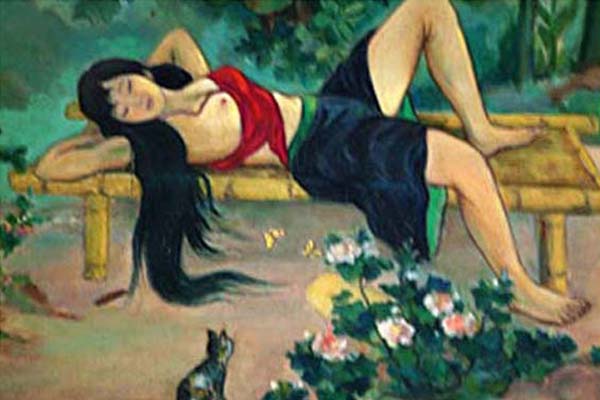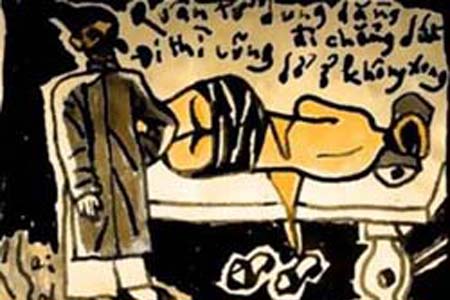Banished by Confucianism, the nude is absent from ancient Vietnamese art, except for a certain number of popular wood-engravings on the walls of the village communal houses. Nguyen Du alone has dared to extol the beauty of a young woman having her bath in these three following lines:
In the fragrant water of her bath,
Kieu immerses her body, a spring flower
Purity of jade, whiteness of ivory,
Perfect shape, Gods master price.
Ho Xuan Huong does not hesitate to glorify the female body in the poem “The girl dozing off in broad daylight.”
In the soft summer breeze rustling from the East
Scarcely has she lain down when she dozes off.
The bamboo comb deep in her hair has dropped.
The red bodice slipping off lays bare her nipples.
The two hills of the Fairyland are still without dew
The Spring with peach blossoms has not yet gushed out
The upright man, hesitating, cannot take his eyes off her
Departing would be frustrating but staying is indecent.

Ho Xuan Huong, alone in the feudal night, dares to deal with the rights of the fair sex and to speak about carnal love without shame.
She escapes the strict censor by an uncommon skill, using allusions and metaphors. Erotic feelings are conveyed by a hidden web of the apparently innocent description of landscapes and familiar objects.
Further information about Hotels in Vietnam, Hanoi hotels or Ho Chi Minh Hotels
In this way she gets by with the things.
Vietnamese classical poetry is conveyed through a language with very musical tonalities; it is made of subtle correspondences between images and sounds as well as a certain incantatory effect of parallelism and rhythm. Sometimes, Ho Xuan Huong’s reader lets himself be so much imbued with the poetic atmosphere that the erotic allusion is subdued.
The translation into English or into any other analytic language is a real betrayal: the reader only thinks of the obscene side if indeed there is something obscene and for-gets to taste the charm and picturesqueness of the work. Let us say that the two readings can coexist. In this lies all the ambiguity of this art, which is both popular and scholarly.
The description of landscapes lends itself easily to such ambiguities.

